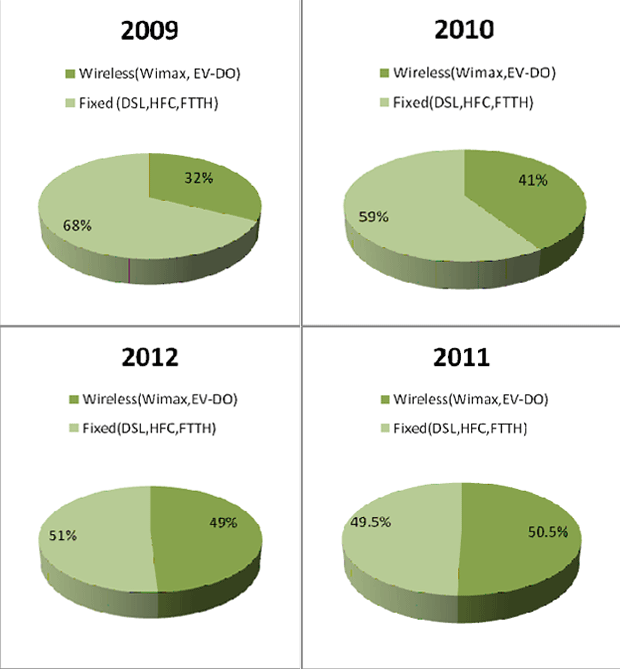|
Broadband has significant economic importance for any country
whether developing or developed. With changing dynamics of the world
economy, the business and governments rely heavily on internet based
technological infrastructure that enables well-connected economic
resources of a country. Moreover, these days many of the industries are
shifting to internet based delivery of their product and services which
require expanded and rubout provision of broadband service in the
country. Pakistan has made considerable progress on strengthening its
broadband infrastructure during last decades. In following sections, we
will explore the current state of broadband in Pakistan.
According to the annual report 2011-2012 of PTA (Pakistan
Telecommunication Authority) by the end of June 2012 the broadband
subscribers in Pakistan are 2,101,315 showing a staggering 41% growth
rate. The main broadband service provider in Pakistan is PTCL with its
huge customer base and well laid infrastructure providing wireless and
wired services across the nation. The number of broadband subscribers
associated with PTCL is 1,262,732, which is a remarkable figure. The
company claims having 60% share in the broadband market. The second
biggest player is WATEEN which increased its subscriber list by 36%
owing to major overhauling of its business processes and introduction of
further capital in October making the total subscribers to 297,503 in
the last fiscal year. WATEEN claims share of 14.2% in the broadband
market. WORLDCALL stands at third position with 181,311 subscribers and
claims 8.6% of the market. Wi-tribe and Qubee are also well known
broadband service providers in Pakistan having shares of 9.4% and 3.5%
in the market with 197,151 and 72,893 subscribers respectively at the
end of June 2012. The remaining 3.5% of market is claimed by other
providers according to the PTA annual report 2011-2012.
|
|

Figure1: Growth in Broadband Subscriber
|
|

Figure2: Shares in Broadband Market
|
|
The broadband penetration in the country has increased to 1.2% at the
end of FY 2012 as compared to 0.89% as of June 2011, despite the fact
that the broadband net additions, and growth rates are quite satisfying,
there are few factors including high cost of entry, low literacy level,
lack of awareness etc. which needs to be focused by the regulators,
services providers and government to improve the progressive penetration
of broadband in Pakistan. These factors (high cost of entry and
infrastructure) are playing as barriers role to entry in the industry,
these should be minimized if broadband industry is to be improved by
encouraging more players to enter the market. Keeping in mind the
important role played by agriculture industry in Pakistan, PTA launched
CVCT program (cellular village connection trial) in an effort to
capitalize unused potential. Other efforts for better awareness of
internet connectivity and broadband services in agriculture industry
include seminars on telecom potential. (Reference page 16, PTA report).
Tele-density is also a good measure for broadband penetration within a
particular country, total tele-density of the country reached to 71.7%
showing growth of 5% FY2012.
|
|

Figure3: %Broadband Penetration in seven years |
|
In Pakistan the broadband market is grouped into five segments based on
the available options, i.e. DSL, EV-DO, FTTH, HFC and Wimax. According
to the PTA annual report, the wireless technologies have claimed large
share in the broadband band . The graph below shows the changes in the
demand of wireless technology in the broadband market. The annual report
says that the wireless technologies have increased their shares in the
market from 32% to 56%. Up till now, Wimax, & Ev-DO are the two main
wireless technologies in Pakistan. But the fact remains as such that the
biggest player among the broadband technologies is DSL claiming 42%
subscriber while EV-DO and Wimax are in close rivalry by claiming a
share of 28%.1 and 27.8% respectively.
|
|

Figure4: Broadband Technology Trends in four Years |
*Note: The statistical data and values are taken
from PTA Annual report 2011-2012 |
| |